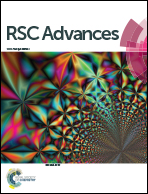Secondary polarization in electrorheological phenomenon†
Abstract
Hollow TiO2 nanospheres were fabricated and adopted as dispersing materials in ER fluids with different viscosities in order to investigate variation of polarized particles before and after the formation of chainlike structure in electrorheological (ER) fluids. Results showed that the ER fluid with low viscosity had better ER efficiency than that with high viscosity, which was ascribed to the better ability of low viscosity ER fluid in maintaining chainlike structures. From an analysis of dielectric properties, it was found that increase of permittivity of ER fluids at low frequency should result from the distribution change of polarized particles in ER fluids. Distribution variation of polarized particles would induce the increase of electric field strength in the region of chainlike structure, which was called “secondary polarization”. This secondary polarization led to an increase of the number of charges on the surface of polarized particles, causing further enhancement of electrostatic interactions between polarized particles. Moreover, the magnitude of polarized charge caused by secondary polarization was much larger than that caused by interface polarization, which suggested that the secondary polarization played an important role in the ER phenomenon. A novel model with detailed explanation about the ER effect is proposed. Furthermore, relationships among the polarizability of dispersed particles, characteristic of dielectric spectrum at low frequency, and ER properties are discussed in detail.


 Please wait while we load your content...
Please wait while we load your content...